
Sign Up
Want to receive a newsletter to learn more about KuneKune pigs and other educational information? Sign up to have them delivered right to your inbox.
We look forwarded to sending you some great info.
Mastering KuneKune Hoof Care
Are you a proud owner of KuneKune pigs and want to ensure their overall health and well-being? One key aspect of their care is hoof trimming. Proper hoof care is essential for the comfort and mobility of your pigs, as well as preventing potential health issues. In this comprehensive guide, we will walk you through the essential steps to master hoof care for your KuneKune pigs.
From understanding the anatomy of the hoof to identifying common hoof problems, we will equip you with the knowledge and skills needed to confidently trim your pig's hooves. We will also explore the necessary tools and techniques, providing practical tips and advice along the way.
By mastering hoof care, you can help prevent lameness, discomfort, and other hoof-related problems in your KuneKune pigs. Whether you are a beginner or have some prior experience, this guide will empower you to become proficient in hoof trimming and ensure the overall health and happiness of your pigs.
Do not neglect this critical aspect of pig care. Let us dive into the world of hoof trimming and take the first steps towards mastering this essential skill for KuneKune pig owners.
Searching for something specific related to KuneKune Hoof Care? Use the links below to be taken to that specific area of the article.
Essential Guide to KuneKune Pig Hoof Care

Importance of Hoof Care for KuneKune Pigs
Proper hoof care is essential for the overall well-being of your KuneKune
pigs. Hoof trimming not only ensures their comfort and mobility but also helps prevent a range of health issues. Neglecting hoof care can lead to painful conditions such as lameness, hoof rot, and infections.
KuneKune pigs are known for their grazing habits and relatively active
lifestyle. Their hooves are constantly exposed to various terrains, from soft
grass to rough surfaces. Regular hoof trimming helps maintain the proper
balance and length of the hooves, ensuring that your pigs can move comfortably and efficiently.
Additionally, by regularly inspecting and trimming the hooves, you can identify early signs of hoof problems, such as cracks, overgrowth, or infections. Early detection and proactive treatment can prevent more serious conditions and discomfort for your pigs in the long run.
Investing time and effort into mastering hoof care for your KuneKune pigs will not only contribute to their overall health and happiness but also strengthen the bond between you and your animals. So, let us delve into the anatomy of a KuneKune pig's hoof to better understand how to care for them.
Take a look at this introduction video
Understanding the Anatomy of a KuneKune Pig's Hoof
To effectively trim your KuneKune pig's hooves, it is crucial to understand their anatomy. A pig's hoof consists of several key parts, each playing a vital role in maintaining proper functionality and preventing hoof-related issues.
The outer part of the hoof is called the hoof wall, which is made up of tough, keratinized cells. It protects the sensitive inner structures of the hoof. The sole is the flat, weight-bearing surface inside the hoof wall. It should be concave and firm. An excessively flat or soft sole can indicate a problem.
The heel is the back part of the hoof, located above the sole. It should be well-supported and free from overgrowth or cracks. The toe is the front part of the hoof, and it should be trimmed to an appropriate length to maintain balance and prevent strain on the pig's limbs.
Inside the hoof, there are various structures, including the digital cushion, which acts as a shock absorber, and the laminae, which connect the hoof wall to the underlying structures. Understanding the anatomy of a KuneKune pig's hoof will help you identify any abnormalities or signs of poor hoof health.
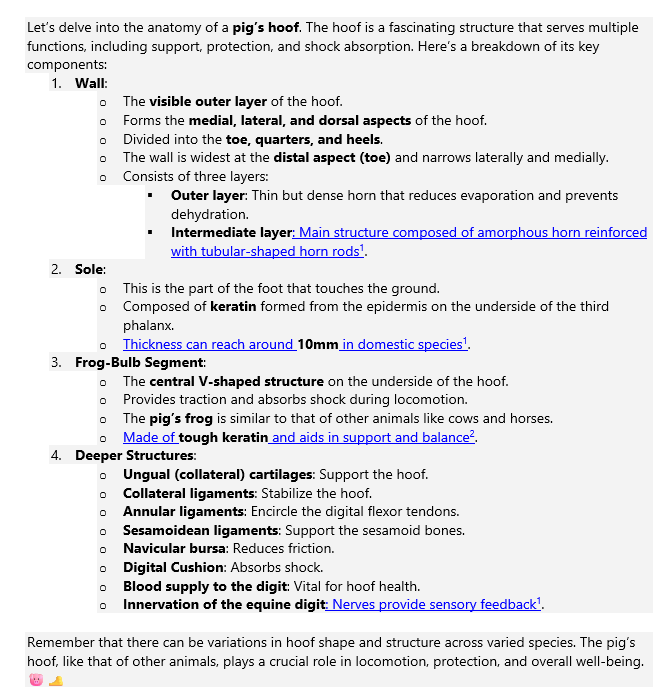
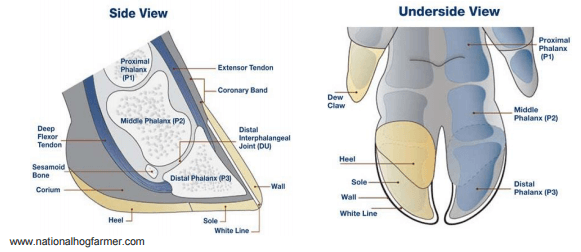
Photo credit to National Hog Farmer.
Signs of Unhealthy Hooves in KuneKune Pigs
Regular inspection of your KuneKune pig's hooves is crucial to identify signs of poor hoof health. Catching the early signs means that you can take the proper action to prevent complications.
Here are some common signs to watch out for:
1. Overgrowth: Hooves that are excessively long and extend beyond the natural shape of the hoof can cause discomfort and affect the pig's gait.
2. Cracks: Cracks in the hoof wall can provide entry points for bacteria, leading to infections and lameness if left untreated.
3. Sole problems: A soft or thin sole, excessive growth, or bruising can signal underlying issues such as poor diet, laminitis, or other health problems.
4. Infections: Foul odor, discharge, or visible signs of infection, such as pus or swelling, should be addressed immediately to prevent further complications.
5. Lameness: If your pig is limping, favoring a specific leg, or showing signs of discomfort while walking, it could be a result of hoof problems.
Regularly examining your pig's hooves and being alert to these signs will enable you to intervene early and provide the necessary care to keep their hooves healthy and strong. Now that we understand the importance of hoof care and can identify signs of poor hoof health, let us move on to the tools and equipment needed for hoof trimming.
Tools and Equipment Needed for Hoof Trimming
Trimming your KuneKune pig's hooves requires the right tools and equipment.
Here is a list of essential items you will need to get started:
1. Hoof Trimmers: Invest in an excellent quality pair of pig-specific hoof trimmers. These should have sharp, curved blades that allow for precise trimming without causing unnecessary discomfort to the pig.
2. Hoof Pick and Rasp: A hoof pick is used to clean debris and mud from the hooves before and during trimming. It helps provide better visibility and prevents the spread of bacteria. A hoof rasp is a file that is used to smooth and shape hooves. Your pig may not love the rasp until it gets used to it.
3. Hoof Stand: A hoof stand is a useful tool that provides stability and elevation, making it easier to work on the hooves. It allows you to have both hands free for trimming and reduces strain on your back.
4. Safety Gear: It is essential to prioritize your safety while trimming your pig's hooves. By wearing gloves, you are protecting yourself from bruises and possible cuts. You may want to consider adding safety glasses in case any trimmings pop up towards your eyes.
Having the right tools and equipment will make the hoof-trimming process more efficient and safer for both you and your pig. With these in hand, let us move on to the step-by-step guide to proper hoof-trimming techniques.
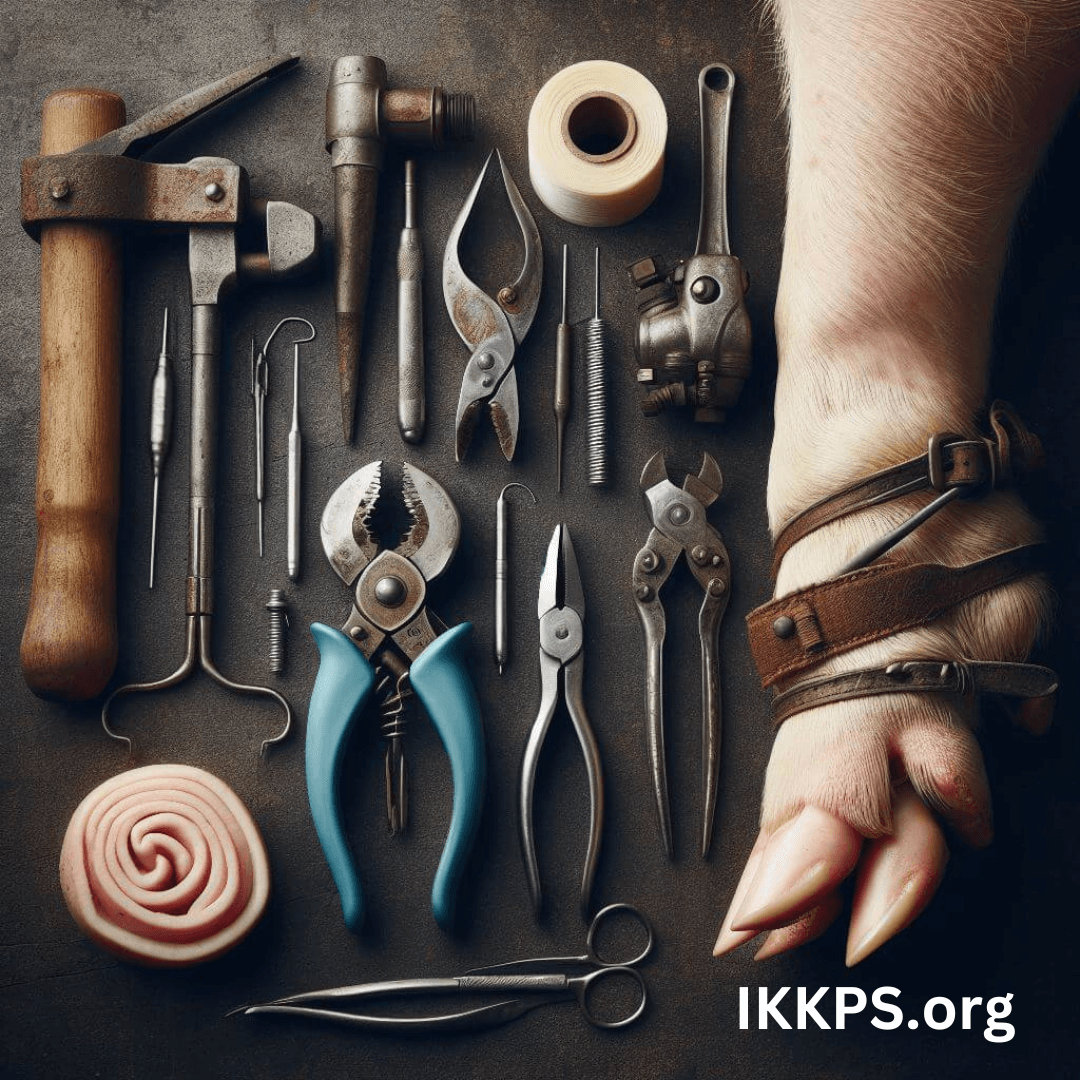
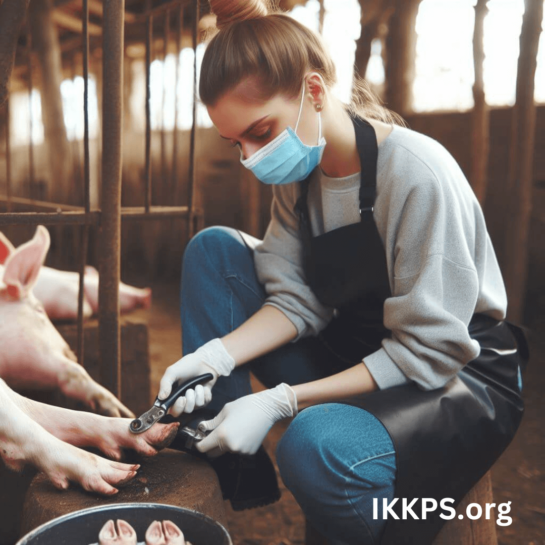
Step-by-step guide to proper hoof trimming techniques.
Proper hoof trimming is crucial for the overall health and well-being of your KuneKune pigs.
Here is a step-by-step guide to help you master the art of hoof trimming:
1. Prepare the pig and the tools: Before you begin trimming, ensure that your pig is calm and comfortable. It is best to trim hooves in a clean and dry area. Gather all the necessary tools, including a hoof trimmer, rasp, and hoof pick.
2. Understand the anatomy of the hoof: Familiarize yourself with the various parts of the hoof. The hoof consists of the wall, sole, frog, and heel. The wall is the hard outer layer, while the sole is the softer inner part. The frog is a V-shaped structure in the center of the hoof, which provides cushioning and traction.
3. Trim the wall: Start by trimming the wall of the hoof. Use the hoof trimmer to carefully remove any excess length. Trim in small increments to avoid cutting too much at once. Ensure that the wall is even and level to promote proper weight distribution. If your pig is moving around wait for the pig to settle.
4. Trim the sole: Next, focus on trimming the sole of the hoof. Use the rasp to gently remove any overgrown or flaky areas. Be cautious not to trim too aggressively, as this can cause discomfort and bleeding. Aim for a smooth and flat sole.
5. Address the frog: Lastly, attend to the frog of the hoof. Use a hoof pick to clean any debris or dirt from the frog. Avoid cutting into the frog unless necessary, as it provides essential support and cushioning.
This is a new skill and like all new skills, it will take time. Be patient with yourself. If you are unsure or uncomfortable trimming the hooves yourself, consider seeking help from a professional hoof trimmer or even another experienced breeder in your area. I used to go trim my friend's KuneKune pigs as she was nervous. After a few times, she gained the confidence to do it herself. Regular practice and observation will enhance your skills and make the process easier over time.
This video was done by KC Farms in TN
Preventive measures for maintaining healthy hooves.
Prevention is key when it comes to maintaining healthy hooves for your KuneKune pigs.
Here are some preventive measures you can take to ensure optimal hoof health:
1. Provide a proper diet: A balanced and nutritious diet is essential for overall pig health, including hoof health. Ensure that your KuneKune pigs have access to quality forage, fresh water, grazing, and a balanced commercial pig feed. Consult with a veterinarian, an experienced Breeder or your mentor, or a pig nutritionist to determine the appropriate diet for your pigs.
2. Maintain clean and dry living conditions: Wet and muddy environments can contribute to hoof problems, such as hoof rot. Provide your pigs with clean and dry bedding, and regularly clean their living areas to minimize the risk of infections and hoof-related issues.
3. Regular exercise and hoof wear: Regular exercise helps promote healthy blood circulation and hoof wear. Allow your KuneKune pigs ample space to roam
and engage in natural behaviors. This will naturally wear down their hooves and prevent excessive growth.
4. Regular hoof inspections: Make it a habit to regularly inspect your pig's hooves for any signs of overgrowth, cracks, or infections. Early detection and intervention can prevent more serious hoof problems from developing.
By implementing these preventive measures, you can significantly reduce the risk of hoof-related issues in your KuneKune pigs and ensure their overall well-being.
Common hoof problems in KuneKune pigs and how to treat them.
Despite our best efforts, KuneKune pigs may still encounter hoof problems.
Here are some common hoof problems you may come across and how to treat them:
1. Overgrown hooves: Overgrown hooves can cause discomfort and affect your pig's mobility. Regular hoof trimming, as discussed earlier, is crucial to prevent and address overgrown hooves. If the hooves have become severely overgrown, seek assistance from a professional hoof trimmer or a veterinarian.
2. Hoof cracks: Hoof cracks can occur due to numerous factors, including trauma or excessive moisture. Small cracks can be managed by trimming the hoof and ensuring proper hoof care. However, deep or infected cracks may require veterinary intervention. Keep the hooves clean and dry to prevent further cracking. There are several products available to retain moisture - even at your local Tractor Supply.
3. Hoof rot: Hoof rot is a bacterial infection that affects the hoof and surrounding tissues. It is often caused by prolonged exposure to wet and dirty conditions. Treatment usually involves trimming the affected area, cleaning the hoof thoroughly, and applying appropriate antibiotics or antiseptics. Severe cases may require veterinary care.
4. Abscesses: Hoof abscesses can develop when bacteria enter the hoof through a small puncture or crack. They are often accompanied by lameness and swelling. Treatment involves locating and draining the abscess, followed by proper cleaning and bandaging. Consult a veterinarian for guidance on abscess treatment.
Remember, if you are unsure about the severity or treatment of any hoof problem, it is always best to consult a professional. Prompt and appropriate treatment can help prevent further complications and ensure a speedy recovery for your KuneKune pigs.
Hoof care schedule and regular maintenance tips
Establishing a regular hoof care schedule is essential to maintain healthy hooves for your KuneKune pigs.
Here are some guidelines for a proper hoof care routine:
1. Frequency of hoof trimming: On average, KuneKune pigs require hoof trimming every 3-4 months. However, this can vary depending on the individual pig's hoof growth rate and environmental factors. Regularly inspect the hooves and trim, as necessary.
2. Cleaning and inspection: Make it a habit to clean and inspect your pig's hooves at least once a week. Remove any debris or dirt using a hoof pick, and check for any signs of overgrowth, cracks, or infections. Early detection and intervention can prevent more serious issues.
3. Monitoring environmental conditions: Pay attention to the living conditions of your pigs. Ensure that their living areas are clean, dry, and free from excessive moisture or mud. Regularly check for any potential hazards that may contribute to hoof problems.
4. Observing pig behavior: Regularly observe your pigs' behavior and mobility. If you notice any changes, such as limping or difficulty walking, it may indicate an underlying hoof issue. Promptly investigate and address the problem to prevent further discomfort.
By following a regular hoof care schedule and incorporating these maintenance tips into your routine, you can significantly contribute to the overall hoof health of your KuneKune pigs.
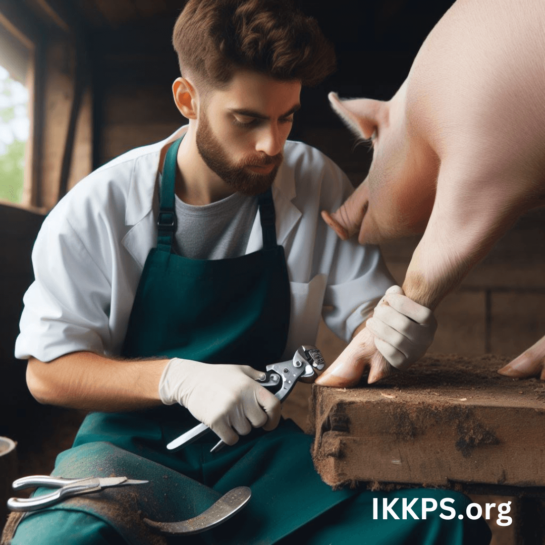
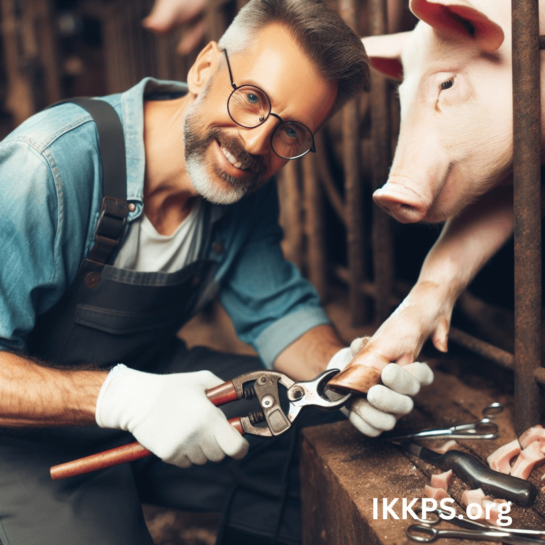
Hiring a professional hoof trimmer vs. DIY hoof trimming
As a KuneKune pig owner, you may wonder whether to hire a professional hoof trimmer or perform the hoof trimming yourself. I know for me this was a task I dreaded. However, the docile and easygoing temperament of KuneKune pigs does make it much easier. I would feed my pigs and wait for them to lay down and be relaxed. Then I would take a blanket and sit it on the ground and further relax them by giving a belly rub. Then I would begin trimming. If they were opposed and got up, I just let them go. Sometimes it may take up to 4 days to get each hoof completed but, I was in no hurry!
Here are some things to keep in mind:
1. Experience and confidence: If you have prior experience and feel confident in your hoof trimming skills, DIY hoof trimming can be a cost-effective option. However, if you are a beginner or lack confidence, it may be safer to hire a professional hoof trimmer who has the necessary expertise.
2. Time and availability: Hoof trimming requires time and patience. Consider your availability and schedule when deciding whether to tackle the task yourself or hire a professional. A professional hoof trimmer can efficiently complete the job, saving you time and effort.
3. Physical limitations: Hoof trimming can be physically demanding, especially if you have multiple pigs or larger-sized pigs. If you have physical limitations or health concerns, hiring a professional hoof trimmer ensures the task is done safely and effectively.
4. Complex hoof problems: If your KuneKune pig has complex hoof problems or requires specialized care, it is advisable to consult a professional hoof trimmer or a veterinarian. They have the knowledge and experience to address more challenging cases.
Consider your comfort level, resources, and the specific needs of your pigs when deciding whether to hire a professional or perform DIY hoof trimming. Ultimately, the goal is to provide the best hoof care for your KuneKune pigs.
Frequently asked questions
How often do their hooves need trimming?
Pigs need their hooves trimmed once or twice a year. Regular hoof care ensures their comfort and mobility. This can depend on the surfaces that your pigs are on. For example: I have very hard, rocky areas in my pasture. I use this area for feeding so it is even more compacted. My pig's hooves were naturally kept shorter in this terrain so my trimmings were not quite as often. If your farrowing quarters have concrete, your sows may need less trimming than your boars.
What should I look for during the hoof inspection?
Examine the coronary band for signs of heat, swelling, sensitivity, or discharge (which could indicate infection). Make sure nothing is stuck in their hooves. Check the growth to make a note of when the next trimming may be needed.
How do I desensitize my pig for hoof trimming?
Start handling and filing their hooves when they are young. This makes trimming easier as your pig grows. Having a positive relationship with your pig helps as they trust you and may accept you trimming their hooves more than say a professional.
How do I maintain the proper hoof length and shape?
- Trim down to level the growth with the heel or the soft pad of the hoof.
- Avoid overfeeding, as overgrown hooves can cause pressure and pain on joints and ligaments.
Registry Office
17500 Hamilton Arms Court Dewitt, VA 23840